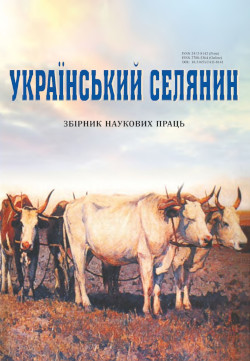Transformations in the social status and moral-ethical behavior of peasants during the collectivization of agriculture and the Holodomor of 1932–1933 (based on the memoirs of S. M. Korinenko, born in 1904, resident of Medvezha village, Nemyriv district, V
Main Article Content
Abstract
Abstract. The purpose of the article is to investigate the specifics of collectivization and the Holodomor of 1932–1933
through the memoirs of a single peasant family, to analyze the motivating factors behind new manifestations in the moral and
ethical behavior of peasants under the conditions of forced changes to traditional farming practices and dekulakization, and to
assess the impact of economic, social, and moral factors on their behavior and community ties.
The scientific novelty of the article lies in its examination, through the memoirs of one family, of the impact of collectivization
and the Holodomor on the social status, moral and ethical behavior, relationships, psychological transformations, and
survival strategies of peasants amidst the Soviet policies of the 1930s.
Conclusions. The study analyzes social changes in the Ukrainian village at the intersection of two eras: the period before collectivization
and the first two years of the collectivized village’s existence. Using the example of one peasant family, their life path and the peculiarities of their moral and ethical behavior toward fellow villagers, particularly during the Holodomor of 1932–1933, are traced. The article is based on the memoirs of this peasant family, as well as on contemporary scholarly works by Ukrainian historians researching the issues of agricultural collectivization and the Holodomor in Ukraine. It highlights the process of forming a new social group-activists of the collective farm movement, the founders of the kolkhoz in the village of Medvezha and the ways they established themselves within the rural community. Violence and coercion against individual farmers became the primary means of implementing the state policy of agricultural collectivization. The activists’ behavior was rooted in their rejection of the peasants’ right to individual farming, aligning with the general policy of the Soviet authorities. Peasants experienced significant psychological discomfort due to the destruction of their traditional way of life and sought to preserve customary traditions. The transformations in their social status and moral-ethical behavior should be viewed as efforts toward self-preservation and adaptation to new living conditions.
Article Details
References
Chorna knyha Ukrainy. [The Black Book of Ukraine: collection of documents, archival materials, letters,
reports, articles, studies, essays]. (1998) (Ed). F. I. Zubanych. Kyiv: Vydavnychyi tsentr «Prosvita». [in Ukrainian].
Fedko, O. (2025) O. Sotsialna istoriia selianskoi simi Pelahii Fedkovoi (seredyna 1940–1950 rr.) [The
social history of the peasant family of Pelahia Fedkova (mid–1940s–1950s)]. Ukrainskyi Selianyn [Ukrainian
peasant], 31. [in Ukrainian].
Holod 1932–1933 rokiv na Cherkashchyni: dokumenty i materialy / Derzhavnyi arkhiv Cherkaskoi obl.
[Famine of 1932–1933 in the Cherkasy region: documents and materials]. (2002) (Ed) T. A. Klymenko, S. I.
Kononenko, S. I. Kryvenko. Cherkasy. [in Ukrainian].
Holodomor — henotsyd 1932–1933 rr. v Ukraini: materialy Vseukrainskoho kruhloho stolu, 21 lystopada
r. [The Holodomor — genocide of 1932–1933 in Ukraine: materials of the All-Ukrainian round table, November
, 2024] (2024). Cherkasy: ChNU, 2024. [in Ukrainian].
Holodomor 1932–1933 rr. v Ukraini na storinkakh hazety «Ameryka» [The Holodomor 1932–1933 in
Ukraine on the pages of the newspaper «America»]. (2024) (Ed) S. V. Kornovenko. Cherkasy. [in Ukrainian].
Holodomor 1932–1933 rr. v Ukraini na storinkakh hetmanskoi presy: hazety «Sich» i «Nash stiah» [The
Holodomor 1932–1933 in Ukraine on the pages of the Hetmanate press: newspapers «Sich» and «Nash stiah»]
(2024) (Ed) S. Kornovenko. Cherkasy. [in Ukrainian].
Hudz, V. (2015) Vtraty ukrainskoho selianstva vid Holodomoru v dzerkali suchasnoi istoriohrafii [Losses
of the Ukrainian peasantry due to the Holodomor in the mirror of modern historiography]. Ukrainskyi Selianyn
[Ukrainian peasant], 15, 3–9. [in Ukrainian].
Kalinkina, S., Kornovenko, S., Markova, S. & Romanets, N. (2017) «Velykyi perelom» na seli. Final
selianskoi revoliutsii (1929–1933 rr.). [«The Great Break» in the countryside. The end of the peasant revolution
(1929–1933)]. Cherkasy. [in Ukrainian].
Knyha pamiati zhertv Holodomoru 1932–1933 rr. u Zhytomyrskomu raioni. [Memorial book of the victims
of the Holodomor of 1932–1933 in the Zhytomyr region]. (2008) (Ed) L. A. Kovalchuk. Zhytomyr. [in Ukrainian].
Kolektyvizatsiia i holod na Ukraini, 1929–1933: zbirnyk dokumentiv i materialiv [Collectivization and
famine in Ukraine, 1929–1933: collection of documents and materials]. (1992) (Ed) S. V. Kulchytskyi. Kyiv:
Naukova dumka. [in Ukrainian].
Kulchytskyi, S. (2013) Stalinska «revoliutsiia zhory»[Stalin’s «revolution from above»]. Problemy istorii
Ukrainy: fakty, sudzhennia, poshuky. [Problems of Ukrainian History: Facts, Judgments, Searches], 22, 113. [in
Ukrainian].
Kulchytskyi, S. (2013) Ukrainskyi Holodomor: otsinka vtrat [The Ukrainian Holodomor: loss assessment].
Kraieznavstvo. [Local History], 364–372. [in Ukrainian].
Markova, S. (2015) Suspilni ta politychni transformatsii v ukrainskomu seli v konteksti formuvannia
totalitarnoi systemy (1917–1933 rr.). [Social and political transformations in the Ukrainian village in the context
of the formation of a totalitarian system (1917–1933)]. Kamianets-Podilskyi. [in Ukrainian].
Marochko, V. (2007) Vyznannia Holodomoru 1932–1933 rr. v Ukraini — henotsydom: istorychnyi fakt
politychnoho samoutverdzhennia ta moralnoho ztsilennia natsii [Recognition of the Holodomor of 1932–1933 in
Ukraine as genocide: a historical fact of political self-assertion and moral healing of the nation]. Problemy istorii
Ukrainy: fakty, sudzhennia, poshuky. [Problems of Ukrainian History: Facts, Judgments, Searches], 16, 270–276.
[in Ukrainian].
Teleguz, A. & Teleguz I. (2012) Naslidky Holodomoru — henotsydu 1932–1933 rokiv dlia ukraintsiv
(do 80-richchia trahedii — masovoho vynyshchennia ukrainskoho narodu). [Consequences of the Holodomor —
genocide of 1932–1933 for Ukrainians (on the 80th anniversary of the tragedy — mass extermination of the
Ukrainian people)]. Kyiv. [in Ukrainian].
Z simeinoho arkhivu. [From the family archive]. [in Ukrainian].
Zemelnyi kodeks USRR. Zbirnyk uzakonen i rozporiadzhen robitnycho-selianskoho uriadu USRR. [Land
Code of the Ukrainian SSR. Collection of laws and regulations of the workers’ and peasants’ government of the
Ukrainian SSR]. (1992). Kharkiv. [in Ukrainian].

